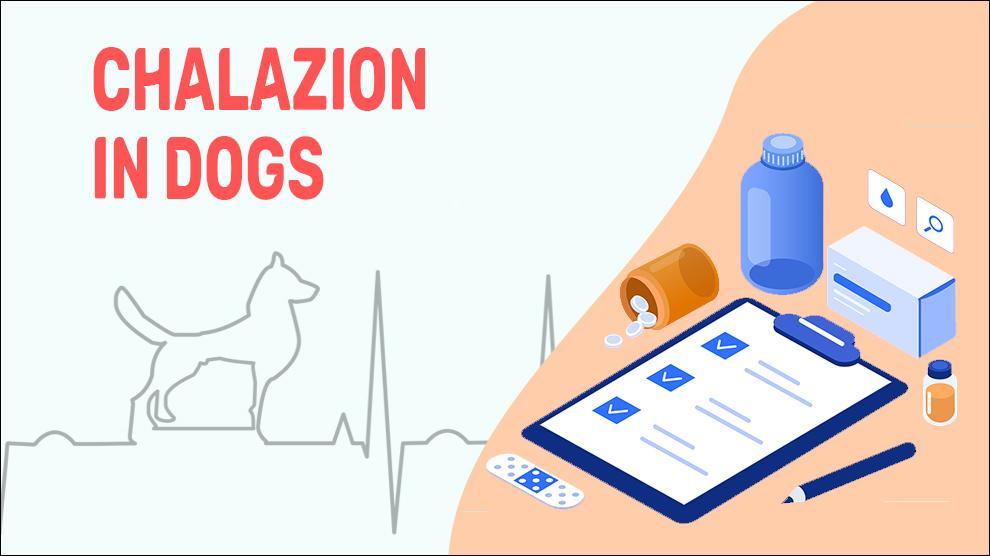What Is Chalazion In Dogs?
Chalazion in dogs means non-neoplastic, focal yellow lumps or nodules or swelling in the meibomian (or tarsal) glands caused by the accumulation of secretions on the inside edge of the lower or upper eyelid. Typically, chalazion (plural: chalazia) are benign but sometimes they occur due to obstruction of glandular secretion outflow by meibomian gland tumor leading to glandular rupture.
Chalazion results in a granulomatous reaction and chronic inflammation. Commonly seen in older animals, these are also called meibomian cysts. When inflamed, a dog will rub or scratch at its face or eyelids due to irritation. This can lead to secondary inflammation of the palpebral conjunctiva (the inner region of the eyelid).
There are several factors for the eye irritation that can lead to Chalazion. Dogs are more affected by this eye problem than cats and this is usually bilateral (affects both eyelids).
A chalazion can be painful sometimes but usually, this will go away without treatment in a month or so. It is better to treat chalazion in the first instance as new lesions may develop. Local recurrences due to inadequate drainage may result in sebaceous gland carcinoma.
Symptoms Of Chalazion In Dogs
- Lagophthalmos (unable to close eyes completely).
- Tearing or wearing or Abrasions of skin (dermatillomania).
- Blepharospasms (uncontrolled blinking or squinting).
- Redness of the eyelid (hyperemia) and/or sclera (the white part of the eye).
- Concurrent conjunctivitis
- Scaly or Flaky skin close to the eye.
- Elevated, pinpoint openings of the meibomian glands.
- Eye discharge (containing water, pus or mucus.
- Formation of papule - Inflamed bumps in the skin, without pus.
Treatment Options For Chalazion In Dogs
The course of treatment will depend on the cause of chalazion. They can be:
- Antibiotics: For the application of the appropriate antibiotic treatment, an antibiogram should be performed (gentamicin, neomycin, Terramycin).
- Fungal or Parasitic Infection: The suitable antifungal or antiparasitic treatments should be provided depending on the cause.
- Immune-mediated: Immunosuppressive therapy (medications that suppress the immune system) may be required.
- Cryosurgery: If the chalazion is caused by a tumor or congenital disease, cryosurgery (cryotherapy) will be necessary.
Home Remedies For Chalazion In Dogs
- Keep your dog active: Keep your dog busy in some creative, fun ways.
- Increase Immunity - Feed your dog the right foods as the gut contains about 70 percent of the dog’s immune system.
- Weight management for your dog is important.
- Supplementing for healthy eyes - help your dog have healthy ocular hygiene with supplements.
- Make your dog more comfortable: Cleanse eyelids to remove crusts (dried discharge) with lukewarm water with a half-teaspoon of salt.
You can use physiological saline or a commercial eye cleansing agent (such as Eye Scrub) or lactated Ringer’s solution.
Apply warm compresses for 5 to 15 minutes, 3 to 4 times daily, avoiding surfaces of the eyes.
Apply cooled chamomile tea to a cotton ball and clean the affected eye.
How To Prevent Chalazion In Dogs?
Chalazion due to the hereditary abnormality can be prevented by stopping the breeding of affected dogs so that the risk of passing the condition on to the next generation is averted.
Allergy-related: Try to remove or avoid the allergens to prevent future outbreaks.
Food-related allergies: Consult with the vet for any specialized hypoallergenic diets.
Affected Dog Breeds Of Chalazion
Senior Dogs, Rottweiler, Collie, English Bulldog, Shih Tzu, Pekingese, Golden Retriever, Chow Chow, Lhasa Apso, Labrador Retriever, Poodle, Pug, Shar Pei
Causes And Diagnosis For Chalazion In Dogs
- Causes:
- Dirt or sand.
- Eyelid abnormalities
- Prominent nasal folds
- Lagophthalmos (inability to close eyes completely).
- Ectopic cilia
- Changes in the consistency of the sebum secretion.
- Viral infections
- Parasitic infections
- Traumatic injuries to the eye.
- Adenocarcinomas and Sebaceous adenomas
- Eye diseases (dry eye syndrome, keratitis, conjunctivitis, etc).
- Mortality:
There is no mortality due to this condition documented yet.
- Diagnosis:
- Schirmer tear test
- Fluorescein dye test
- Slit light exam
- Intraocular pressure test
- Prognosis:
A chalazion isn't a lethal condition, but it can ultimately lead to eye problems. Discuss with your vet to figure out the underlying cause.
Depending on the cause, a chalazion can be treated with either medication to keep the eyes moisturized or surgery.
When To See A Vet For Chalazion In Dogs?
- Lagophthalmos (unable to close eyes completely).
- Tearing or wearing or Abrasions of skin.
- Uncontrolled blinking or squinting.
Food Suggestions For Chalazion In Dogs
- Lean meat protein.
- Low-carb dog food (sweet potatoes, peas, yams, squash, pumpkin).
- Whole, unprocessed, or minimally foods (meats, seafood, grains, legumes, nuts, etc).
- Shrimp, Salmon, Tuna, Cod, Halibut, Trout, and Herring fish.
- Blueberries, Kale, Broccoli, Carrots.
- Oysters and pork.
- Leafy green vegetables (lettuce, spinach, salad greens, parsley, collard greens).
Conclusion
The cause of the chalazion determines the prognosis.
Proper treatment of Infectious causes of chalazion do extremely well and are not at risk of developing problems in the future.
Congenital abnormality caused by chalazion can be surgically corrected, and the prognosis is excellent.
Benign eyelid tumors in dogs can be removed surgically with a good prognosis.
Autoimmune disease or an allergic chalazion, dogs should continue some sort of medical treatment for the long term to control symptoms.

















